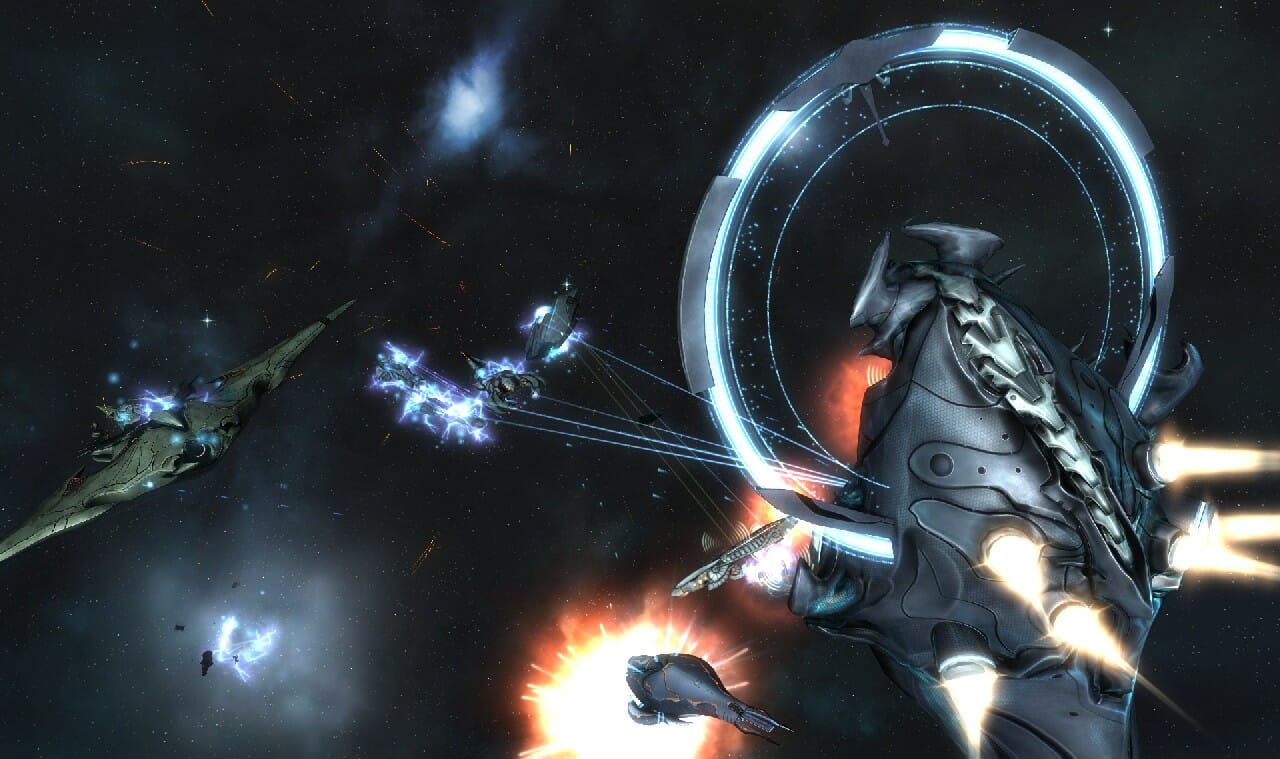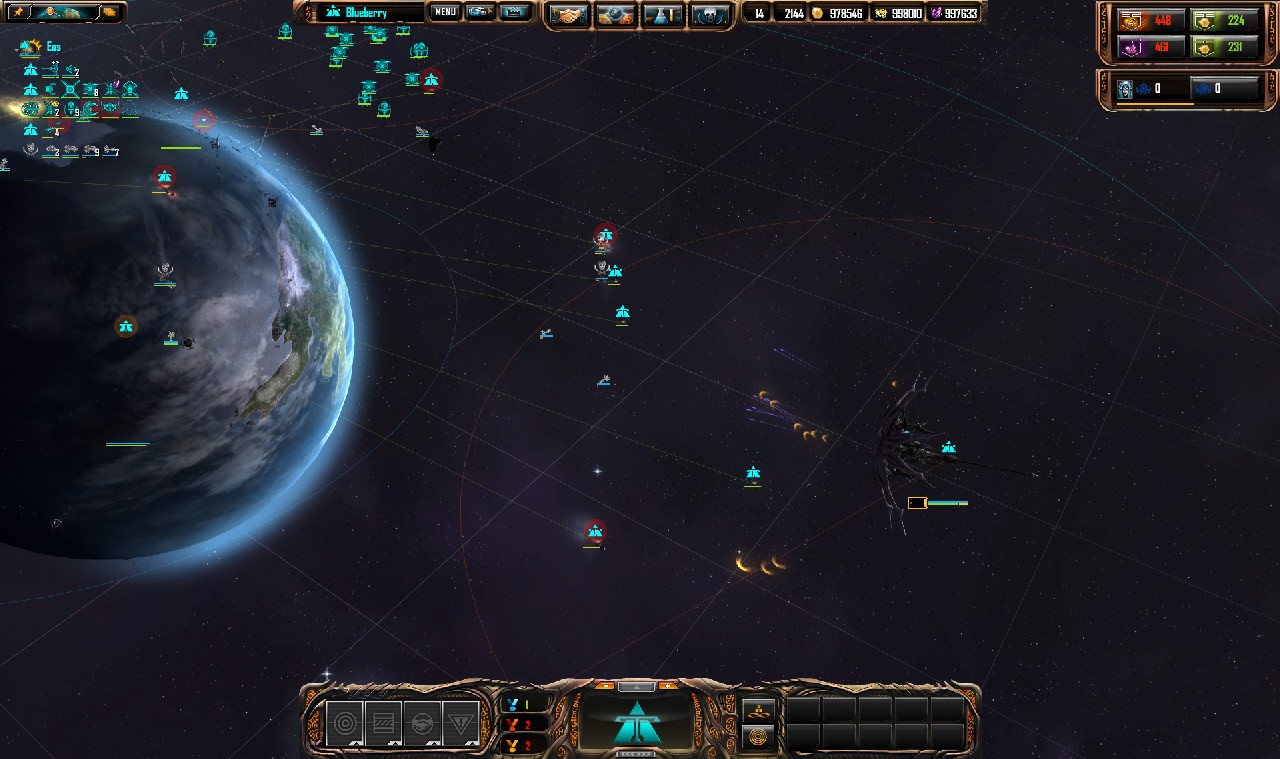
The stand-alone expansion to 2008’s acclaimed and intricate real-time strategy game takes Dan Crabtree back to middle school.
When I was in the seventh grade, I refused to wear pants to dinner. My mother forbade this practice under pain of hunger, a maneuver I then branded the “No Pants Act” and protested by forced sit-ins from my room. My argument followed that if a man-child wished to approach a teenager’s essential moments less-fettered by hand-me-down cargo shorts that was his inalienable right. My own father had fought in wars for as much, I reasoned, and I deserved a dissenting voice. My freedom cry echoed across my bedroom, to no one, “No pantsation without representation!” Just brilliant.
Ironclad Games believes in my revolution, even if I’ve since surrendered to modest slacks. Sins of a Solar Empire: Rebellion, the first stand-alone expansion for the RT4X (Real-Time 4X, for “explore, expand, exploit and exterminate”) title, is a contemplative middle finger to both the restraint and the relative bombast that drive comparable games like StarCraft II or Civilization V. By refusing to fully occupy either the real-time strategy or 4X genres, Rebellion phases into a new breed of space opera. It’s slow, it’s tactical and it’s demanding, casting off the preconceptions of swift combat and authored impetus in favor of tedious empire development and an overdrawn learning curve. Rebellion’s niche fan-base will revel in its singular experience; others will tell it to grow up and wear some pants.
I say “grow up” because Rebellion’s design philosophy pulls so heavily from the wonder years of the strategy game genre. In Civilization II (1996), building a barrack, a primary unit production building, took eight full turns. SimCity 2000 (1993) urged cautious exploratory missions to expand resource pools and valuable real estate at the center of its building mechanics. When Blizzard launched into space in StarCraft (1998), the “Zerg Rush” (or rushing anything in an RTS) was relatively foreign. These older games and the sprightly PC gamers who played them valued well-crafted plans and patience above twitch reactions. As they say, Rome wasn’t built in three turns.
By returning to these formative ideas, Sins of a Solar Empire: Rebellion has drawn a line in the space dust. While StarCraft II cranks up the immediacy, shrinking its maps and growing its units, Rebellion keeps a galactic perspective. Units that hold hundreds of crew members are dwarfed by gigantic planets and even more gargantuan star systems. The smallest map accommodates seven planets and two players, and the largest holds 142 for 10 players.
Swimming between orbits requires time-consuming phase jumps, and larger maps separate entire galaxies by worm holes. Players can fluidly zoom in, out and around any objects to get a sense of the eclipsing size and surprising detail of the rebuilt graphics engine, although active play is only practical when zoomed to the planetary level. I found myself zooming in and out of planets often (using the mouse wheel) to navigate between systems, which was aided by a helpful, if gaudy, encyclopedia of friendly and foreign units along the left side of the screen. It enables unit management at a glance, and is especially useful when capital ships are smaller than the mouse reticle. Even the largest ships, the new Titan class, are ants on an interstellar pool table.
This scale presents real opportunity for the player to spread out across several planets and harvest their resources (credits from taxes, metal and crystal from asteroids). Instant exploration becomes the de facto strategy after even one match with a trickling resource supply. Even with scores of planets in an empire, the comprehensive buffet of ships and civilization upgrades leaves dozens of branching tactical options for how best to spend the space scrilla. Invest in diplomacy to win a cold war. Spend on lasers and shields, because percentages matter. Construct a seamless defensive perimeter and play the waiting game. Hire AI pirate mercenaries to amass an instant armada and make life hell for the other guy.

Point being, this universe is bristling with potential, and it’s all player-directed. The single player mode is analogous to online multiplayer outside of the bots. Rebellion doesn’t rest on a campaign, but places the burden of intrigue on emergent narrative, as is apparent in the user-created maps from the intuitive map editor.
I wanted to learn more about the hive-minded space elves of the Advent, and discover the secret behind the Vasari’s retreat (teased in the opening cinematic). Instead, I was redirected to study my own ability to conquer or relinquish irrelevant planets for an average of five hours a match, for which I received a few flashes of imploding space stations and world liberation. I learned that I’m an impatient zergling—the more you know.
Rebellion’s infrequent moments of high action drip like an IV into the lengthy scenarios, an accent I eventually found irresistible. Like any modern RTS, the arms race can become as exciting as using the armaments (particularly while accruing the 15,000 or so credits to build a race-specific Titan), but because resource collection occurs so slowly at normal speeds, the wait can become excruciating. Once unleashed, Titans and the massive capital ships can level up, deploy fighters and learn unique cool-down abilities. And so the tunnel goes deeper.
Each of the three races (TEC [human], Advent [techno-human], and Vasari [straight-up alien]) has two distinct factions, one Loyalist and one Rebellion, which sport their own Titans and upgrade trees. From a thousand-foot view: TEC Loyalists are isolationists specializing in digging into heavy defenses, TEC Rebels are free-roaming looters and mercenaries, Advent Loyalists use mind control and cultural influence to favorably manipulate battles, Advent Rebels are sacrificial purists akin to zombie raiders, Vasari Loyalists are nomadic miners that use ships to generate wealth, and the Vasari Rebels use collaborative space stations and upgrades to turn an enemy’s power against it. Phew.
The game changers are the Vasari Loyalists, whose Titan can act as a mobile planet to generate ships and income, and whose resource mining of a planet can turn habitable terra into uncolonizable rock. The TEC factions are both more straight-forward plays, using units and structures to build up defenses and mount attacks, and the Advent factions use more subversive means to infiltrate enemy ranks and deteriorate them from the inside out. Every faction has a host of similar-function frigates and capital ships, and structures all perform identically with different coats and names.
I emerged from Rebellion’s deep well of tactical knowledge with two epiphanies. First, this game is as far from casual gaming as Tatooine is from the bright center of the universe. Gamers looking to pop into this solar empire should take the nearest worm hole to the Lylat System. Second, the early RTS model is both frustrating and addicting because with careful decision-making and a clear focus on player interaction comes commensurate amounts of investment and reward.
Perhaps it’s the fate of the tactical PC game to split indivisibly on speed and form, and what a difference the schism makes! I entered Rebellion well worn by the wrote spectacle of the modern RTS, to the point of being happily accustomed. Ironclad’s Rebellion has such inherit gumption and defiant scale that it found its way into my seventh-grade heart where it still lives today, collecting taxes and never growing up. Now if I can just find my pants…
Sins of a Solar Empire: Rebellion was developed by Ironclad Games and published by Stardock. It is available for PC.
Dan Crabtree is an I.T. guy and freelance writer with words on Paste, Ars Technica, Kill Screen, and Gamernode. His dog is considered handsome and well-read. You can find him (the human) on Twitter..